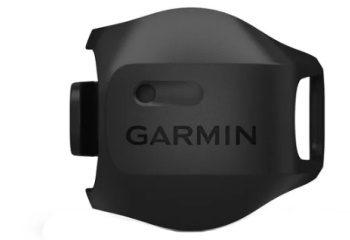 |
|---|
|
|
Understanding how the Garmin
Bike Speed Sensor (BSS) measures speed
The BSS (Bike Speed Sensor) contains a
magnetometer that measures the three dimensional components of the ambient
magnetic field (similar to an accelerometer measuring acceleration). As the
wheel rotates, the magnetometer measures its own rotation within the
surrounding earth's magnetic field. The earth's magnetic field does not vary
much (if at all) over the course of a bike ride. This means that the sensor
doesn't need to concern itself with the variation of the earth's magnetic
field. However, since the product is available in numerous countries around
the world, the product has several consistency checks to ensure that it is
observing the earth's field and not another magnetic feature.
People are often curious if riding by a steel
fence, over an iron manhole cover, passing a car or transformer affects the
sensors. While these materials are magnetic and will contribute to the raw
signal observed by the magnetometer, the BSS has been designed to track the
wheel's rotation correctly while passing these types of magnetic features.
Testing has confirmed that these magnetic features very rarely generate
errors or tracking issues.
The unit has also been tested on bikes used on
magnetic indoor trainers. The BSS will operate correctly when used with a
magnetic fluid trainer.
Magnets and magnetized steel near the sensor
could be particularly troublesome as they would introduce error and noise
into magnetometer data. For this reason, the BSS performs an automatic
calibration routine whenever it is motionless for more than 3 minutes to
minimize the affect of any magnetized components on the bike.
Despite this auto-calibration, the sensor will
likely have challenges if mounted over a dynamo hub (i.e. a hub that
generates power for a light or other device). These hubs typically have
magnetic components which will interfere with the sensor. Since these hubs
are much larger than the typical road/mountain bike hub, the user would
generally mount the BSS on the other wheel.
In addition, magnets are often used in other
wheel speed, cadence or power sensors. Use of any magnets near the sensor
should be limited. Extensive testing with the BSS was done with a Garmin
Speed/Cadence sensor (GSC 10) and no issues were found when the GSC 10 and
its magnets were correctly mounted on a bicycle. However, if a magnet is
mounted too close to the BSS, it could cause the sensor to malfunction. In
general, a GSC 10 type magnet should be a minimum of 10cm away from the
speed sensor. Stronger magnets must be kept a greater distance from the
speed sensor. Ideally, all magnets should be removed from a bicycle when
using the BSS. If necessary, the sensor can be moved to the other wheel if a
customer wants to keep a magnet that is too close to the BSS.
Occasionally, a component on a bicycle will exhibit unnaturally strong magnetism that will interfere with the sensor yielding less accurate results. These magnetized components could be the wheel hub, the free wheel inside the hub, the cassette, chain or other component on the bike and may have become magnetized inadvertently by storing the components in very close proximity to a strong magnet. In this case, it is advised that the user mounts the BSS on the other wheel of the bike.